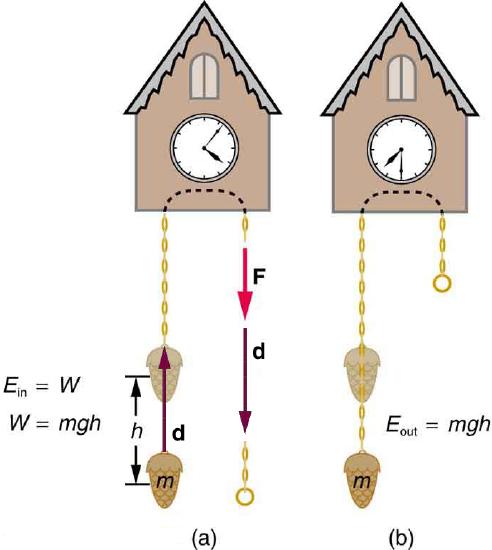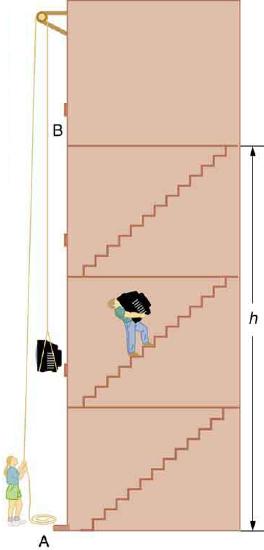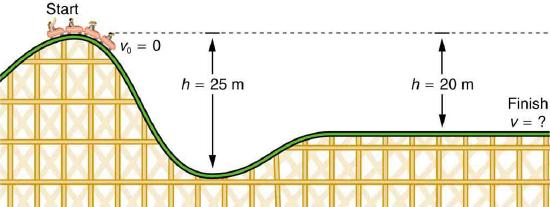3.4: Gravitational Potential Energy
( \newcommand{\kernel}{\mathrm{null}\,}\)
Learning Objectives
- Explain gravitational potential energy in terms of work done against gravity.
- Show that the gravitational potential energy of an object near surface of Earth is given by product of its mass, height, and gravitational acceleration.
- Show how knowledge of the potential energy as a function of position can be used to simplify calculations and explain physical phenomena.
Work Done Against Gravity
Consider lifting a weight (of, say, 5 kg, which weighs about 50 N) from the floor to a table surface at a height of 1 meter from the floor. In lifting this weight, you have done work, both in the usual sense (if you do this lifting of weight over and over, you will eventually get tired) and in the scientific sense we defined in the earlier section (W=Fd, and you applied an upward force as you displaced the weight upward by 1 meter). One thing is different in this scenario, however. Earlier, in describing work-kinetic energy theorem, we said that net work done on an object changes the kinetic energy of the object (ΔKE=Wnet ). But in this case, if you imagine lifting the weight very slowly up to the height of the table, you will find that the kinetic energy of the weight does not change. It starts at zero and remains at zero throughout this very slow motion. What is going on here?
The key difference is that, for this weight, there are now two forces acting on it as it is being lifted. The gravitational force pulls downward, while the force you apply is directed upward. If you are lifting the weight very slowly, then its acceleration is very close to zero, so the net force on it is zero (Fnet=0), which means the net work done on the weight is also zero (Wnet =Fnet d; the applied upward force does positive work, while the downward gravitational force does negative work).
While this is a correct description (the negative work done by the gravity cancels out the positive work done by the applied force), this description misses something. Specifically, you can see that this weight that has been lifted by 1 meter does have more energy than a weight that was resting on the floor. This is how you can see it: if you let go of the weight (after removing the table), as the weight originally at 1-meter height reaches the floor, it gains a substantial kinetic energy as it continues to be pulled by gravity. Rather than saying that this kinetic energy simply appeared as the weight fell through the 1-meter height, we opt for the description that this weight already had this energy, when it was at rest at the 1-meter height, just in a form that was not kinetic energy. We call this energy associated with the height of objects the gravitational potential energy, PEg. And in this example, the energy originally came from the work done by the applied force—rather than considering positive work done by the applied force to be cancelled out by the negative work done by the gravity, we say that this positive work done is stored as positive PEg.
This phenomenon of potential energy turns out to be quite general and goes beyond the gravitational force. There are other forces in nature where negative work done by these forces turns into positive potential energy. We call these forces conservative forces, which will be the subject of the next section. For the purpose of this section, following is the quick derivation of formula for PEg (everything in terms of symbols now). In lifting the weight of mass m through a height h slowly, you have to apply a force equal to its weight, mg. So the work done is W=Fd=mgh, and since it's this work done that is stored as gravitational potential energy, the gravitational potential energy must be:
PEg=mgh.
Converting Between Potential Energy and Kinetic Energy
Gravitational potential energy may be converted to other forms of energy, such as kinetic energy. If we release the mass, gravitational force will do an amount of work equal to mgh on it, thereby increasing its kinetic energy by that same amount (by the work-energy theorem). We will find it more useful to consider just the conversion of PEg to KE without explicitly considering the intermediate step of work. (See Example 3.4.2.) This shortcut makes it is easier to solve problems using energy (if possible) rather than explicitly using forces.

More precisely, we define the change in gravitational potential energy ΔPEg to be
ΔPEg=PEgf−PEgi=mghf−mghi=mg(hf−hi)=mgΔh
Note that Δh is positive when the final height is greater than the initial height, and vice versa. For example, if a 0.500-kg mass hung from a cuckoo clock is raised 1.00 m, then its change in gravitational potential energy is
mgΔh=(0.500 kg)(9.80 m/s2)(1.00 m)=4.90 kg⋅m2/s2=4.90 J.
Note that the units of gravitational potential energy turn out to be joules, the same as for work and other forms of energy. As the clock runs, the mass is lowered. We can think of the mass as gradually giving up its 4.90 J of gravitational potential energy, without directly considering the force of gravity that does the work.
Using Potential Energy to Simplify Calculations
The equation ΔPEg=mgΔh applies for any path that has a change in height of Δh, not just when the mass is lifted straight up. (See Figure 3.4.2.) It is much easier to calculate mgΔh (a simple multiplication) than it is to calculate the work done along a complicated path. The idea of gravitational potential energy has the double advantage that it is very broadly applicable and it makes calculations easier. From now on, we will consider that any change in vertical position Δh of a mass m is accompanied by a change in gravitational potential energy mgΔh, and we will avoid the equivalent but more difficult task of calculating work done by or against the gravitational force.

Example 3.4.1: The Force to Stop Falling
A 60.0-kg person jumps onto the floor from a height of 3.00 m. If he lands stiffly (with his knee joints compressing by 0.500 cm), calculate the force on the knee joints.
Strategy
This person’s energy is brought to zero in this situation by the work done on him by the floor as he stops. The initial PEg is transformed into KE as he falls. The work done by the floor reduces this kinetic energy to zero.
Solution
The work done on the person by the floor as he stops is given by
W=−Fd,
with a minus sign because the displacement while stopping and the force from floor are in opposite directions. The floor removes energy from the system, so it does negative work.
The kinetic energy the person has upon reaching the floor is the amount of potential energy lost by falling through height Δh:
KE=−ΔPEg=−mgΔh,
The distance d that the person’s knees bend is much smaller than the height Δh of the fall, so the additional change in gravitational potential energy during the knee bend is ignored.
The work W done by the floor on the person stops the person and brings the person’s kinetic energy to zero:
W=−KE=mgΔh.
Combining this equation with the expression for W gives
−Fd=mgΔh.
Recalling that Δh is negative because the person fell down, the force on the knee joints is given by
F=−mgΔhd=−(60.0 kg)(9.80 m/s2)(−3.00 m)5.00×10−3 m=3.53×105 N.
Discussion
Such a large force (500 times more than the person’s weight) over the short impact time is enough to break bones. A much better way to cushion the shock is by bending the legs or rolling on the ground, increasing the time over which the force acts. A bending motion of 0.5 m this way yields a force 100 times smaller than in the example. A kangaroo's hopping shows this method in action. The kangaroo is the only large animal to use hopping for locomotion, but the shock in hopping is cushioned by the bending of its hind legs in each jump.(See Figure 3.4.3.)

Example 3.4.2: Finding the Speed of a Roller Coaster from its Height
(a) What is the final speed of the roller coaster shown in Figure 3.4.4 if it starts from rest at the top of the 20.0 m hill and work done by frictional forces is negligible? (b) What is its final speed (again assuming negligible friction) if its initial speed is 5.00 m/s?

Strategy
The roller coaster loses potential energy as it goes downhill. We neglect friction, so that the remaining force exerted by the track is the normal force, which is perpendicular to the direction of motion and does no work. The net work on the roller coaster is then done by gravity alone. The loss of gravitational potential energy from moving downward through a distance h equals the gain in kinetic energy. This can be written in equation form as −ΔPEg=ΔKE. Using the equations for PEg and KE, we can solve for the final speed v, which is the desired quantity.
Solution for (a)
−ΔPEg=ΔKE
becomes
−(PEgf−PEgi)=12mv2f−12mv2i
Noting that the initial speed is zero, and using the formula for gravitational potential energy, we have
−(mghf−mghi)=12mv2f
Taking the initial height as zero gives
−mghf=12mv2f
Solving for the final speed, we find that mass cancels and that
vf=√−2ghf
Substituting known values,
vf=√−2ghf=√(−2)(9.80 m/s2)(−20.0 m)=19.8 m/s
Please note that the height used above was negative. This is because we chose the initial height to be our reference level for gravitational potential energy. Our final height is 20 meters below that reference level.
Solution for (b)
Again −ΔPEg=ΔKE.
Thus,
−(PEgf−PEgi)=12mv2f−12mv2i
Taking the initial height as zero leads to
−mghf=12mv2f−12mv2i
Rearranging gives
12mv2f=−mghf+12mv2i
This means that the final kinetic energy is the sum of the initial kinetic energy and the gravitational potential energy. Mass again cancels, and
vf=√−2ghf+v2i
Now, substituting known values gives
vf=√−2ghf+v2i=√(−2)(9.80 m/s2)(−20.0 m)+(5.00 m/s)2=20.4 m/s.
Discussion and Implications
First, note that mass cancels. This is quite consistent with observations that all objects fall at the same rate if friction is negligible. Second, only the speed of the roller coaster is considered; there is no information about its direction at any point. This reveals another general truth. When friction is negligible, the speed of a falling body depends only on its initial speed and height, and not on its mass or the path taken. For example, the roller coaster will have the same final speed whether it falls 20.0 m straight down or takes a more complicated path like the one in the figure. Third, and perhaps unexpectedly, the final speed in part (b) is greater than in part (a), but by far less than 5.00 m/s. Finally, note that speed can be found at any height along the way by simply using the appropriate value of h at the point of interest.
We have seen that work done by or against the gravitational force depends only on the starting and ending points, and not on the path between, allowing us to define the simplifying concept of gravitational potential energy. We can do the same thing for a few other forces, and we will see that this leads to a formal definition of the law of conservation of energy.
Section Summary
- Work done against gravity in lifting an object becomes potential energy of the object-Earth system.
- The change in gravitational potential energy, ΔPEg, is ΔPEg=mgΔh, with Δh being the change in height and g the acceleration due to gravity.
- The gravitational potential energy of an object near Earth’s surface is due to its position in the mass-Earth system. Only differences in gravitational potential energy, ΔPEg, have physical significance.
- As an object descends without friction, its gravitational potential energy changes into kinetic energy corresponding to increasing speed, so that ΔKE=−ΔPEg.
Glossary
- gravitational potential energy
- energy associated with height of objects on the Earth


